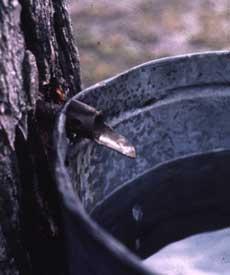Sap

While faster growing and larger trees are generally better sap producers, the volume of sap increases faster than the tree diameter, and sweetness increases with size. Both volume and sweetness increase as the density, depth, and height of the crown of the tree increases. There is no significant difference in sap produced due to soil type, nor due to the placement of tap holes in different positions (under large branches, over roots, etc.). Tap holes on the south side of the tree will yield the first of the day’s sap run. This is the warmest or “sunniest” side of the tree.
2% - 3% sugars
0.03% organic acids
0.003% protein
0.009% miscellaneous
0.014% ash
97% - 98% water
Generally the first and second sap runs produce the best syrup... the lightest color, best flavor, and with little or no sugar sands.
An average of 40 gallons of sap is needed to make one gallon of syrup. This varies to as low as 30 gallons and up to 60 gallons, dependent on such things as the year’s rainfall, the actual length of the sap run, and the total season. Variations in weather result in uncontrollable fluctuations in sap yields year to year and throughout the season.
The first run may begin as early as December, but seldom occurs before Valentine’s Day. This is because of the below freezing temperature at night, and the warm temperatures in the day. The last sap run is generally over by the first week in April. At this time, the buds begin to swell and produce hormones that make the sap bitter.
